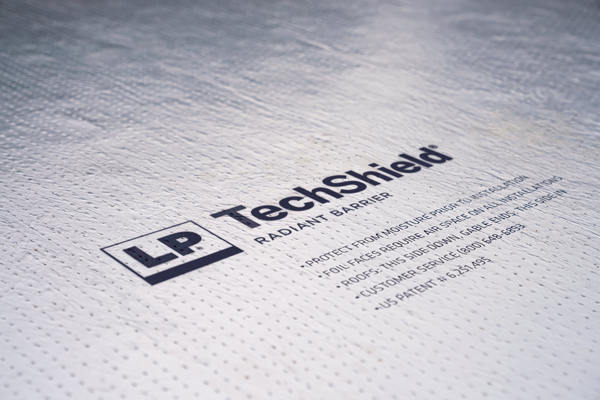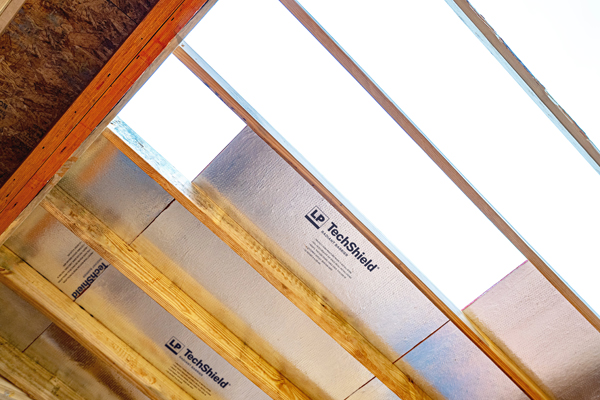Business Advice7 min
How to Talk to Homeowners About Radiant Barrier Sheathing
For homeowners, the gut feeling that a home is truly energy efficient becomes a reality when they open their gas and electric bills at the end of the month. And with efficiency becoming one of the most sought-after traits in new home construction, many homebuyers have shifted toward purchasing or building homes with energy efficiency in mind.
While your clients may not ask directly for radiant barrier sheathing, it’s likely they’ll express their desire for a home that uses less energy, more easily regulates temperature, or can help them be more cost efficient. Communicating the benefits, usage and science behind a product like LP® TechShield® Radiant Barrier can set you and your customers up to reach your goals together.
As you have conversations with your customers you may find them wondering, “Does a radiant barrier work?” Keep this list of top ten benefits on hand as you guide homeowners through their product decisions:
10 Benefits of LP TechShield Radiant Barrier
Can reduce attic temperatures by up to 30° F
Can account for an overall lower HERS score
Helps block up to 97% of the radiant heat in roof panels
Cost-effective way to help make a home more energy efficient
May help qualify for Green Building credits
America’s original and #1 brand of radiant barrier sheathing
Backed by a 20-year transferable limited warranty
VaporVents™ technology with post-lamination incising allows panels to dry more quickly than other radiant barrier sheathing options
Installs like conventional roof sheathing, requiring no additional labor
Proven performance in more than 2 million homes
What Does a Radiant Barrier Do?
With this list in your back pocket, you have the information you need to help your customers understand the value of a radiant barrier. But what do radiant barriers do? And what exactly are they?
The ultimate goal of LP TechShield sheathing is to help reduce cooling costs. Jordan Smith, owner of Smith House Co., chose LP TechShield Radiant Barrier to help improve the energy efficiency of his build.

He shares how radiant barriers work to make structures more efficient.
“There are three ways that heat is transferred: conduction, convection and radiation,” says Smith. “LP TechShield panels take care of the radiation portion.”
On a hot summer day, the sun’s radiant energy hits the shingles and transfers its heat into the attic space. The unique properties of the reflective overlay that covers the underside of the OSB sheathing create the radiant barrier. This prevents up to 97% of the radiant heat absorbed in the roof sheathing from emitting into the home's attic.
Do Radiant Barriers Really Work?
If your client lives in a hot, sunny climate, radiant barriers will be particularly useful. The radiant barrier’s ability to lower heat transfer keeps attic spaces cooler, helping curb energy costs. It can even help improve the efficiency of in-attic HVAC units and reduce the tonnage of the entire system.
Jeff Smith, a contractor rep for Builders First Source in Blairsville, Georgia, has seen the difference a radiant barrier can make firsthand.
“After we installed LP TechShield Radiant Barrier, there was a noticeable difference in the attic space and the upper rooms of the house,” he says. “Because LP TechShield panels deflect radiant heat, it’s 15 to 20 degrees cooler in those areas than what you’d get with conventional OSB.”
Environmental Benefits of Radiant Barriers
Radiant barrier sheathing can help increase the energy efficiency of your clients’ homes and possibly even translate directly to a homeowner’s monthly utility bills.
“In today’s market consumers want to understand the impact on the environment, but they also need to see the cost benefit to their pocketbooks,” said Dan Bridleman, Senior Vice President of Sustainability for KB Home. “Features like LP TechShield sheathing open the door to further educate homebuyers on the availability of building materials with environmental benefits and long-term cost savings for them personally.”
After seeking ways to meet ENERGY STAR® criteria for all its new homes, KB Home became the first national builder to make LP TechShield Radiant Barrier a standard feature on every new build.

Bill Pierce from Shaddock Homes weighs in with his experience as well. According to Pierce, LP TechShield sheathing helps contribute to a home’s value, livability and affordability. “At the end of the day when homeowners get their utility bill, it can be lower due in part to LP TechShield sheathing,” said Pierce.
Discussing the potential for energy savings is a tremendous way to explain the value of LP TechShield sheathing to homeowners.
Curious about other products that can meet the demands of the jobsite and your clients’ needs? Check out our portfolio of resilient product solutions here.
Continue Reading
News & Stories3 min
History of Partnership with Gary Sinise Foundation
The LP Foundation is a proud partner of the Gary Sinise Foundation, which supports wounded veterans in several ways. You can learn more about the LP Foundation here.
Business Solutions
4 minQ&A: How Home Orientation Impacts Continuous Insulation
There’s a lot to consider when it comes to building an energy-efficient home for your clients and the many nuances that change with each build—including its orientation to the sun. We sat down with Neil Freidberg, Building Science Manager at LP, to unpack the impact of home orientation on continuous insulation needs.
Resiliency Solutions
5 minHOW A RADIANT BARRIER CAN IMPROVE BURIED DUCT PERFORMANCE
One of the questions LP® Building Solutions gets from builders often is about burying ducts in attic insulation and whether combining radiant barrier sheathing with blown insulation over ductwork can benefit homeowners. As with most technical situations, the outcome depends on a nuanced approach. Let’s dig in and explore this question.
Sustainability Solutions
8 minHow to Drive Effective Communication and Collaboration on the Jobsite
Every jobsite has a ton of moving parts, from product shipments, supplies, and schedules to subcontractors and homeowners. It’s no wonder that many project teams can struggle to maintain quality jobsite communication and collaboration throughout the building process. And when communication slips, construction companies inevitably deal with costly errors, inefficient workflows, delayed projects, or wasted time, leaving clients and the team frustrated.